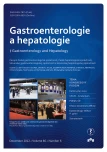Spontaneous intramural hematoma of the small bowel is a rare complication due to an oral anticoagulation therapy
Authors:
B. Kunčak 1; I. Páv 2
Authors‘ workplace:
Klinika vnútorného lekárstva II, FNsP Nové Zámky
1; Gastroenterologická klinika SZU a FNsP, Bratislava
2
Published in:
Gastroent Hepatol 2012; 66(6): 477-481
Category:
Digestive Endoscopy: Case Report
Overview
Spontaneous intramural hematoma of the small bowel is a rare complication in oral anticoagulation therapy. Computed tomography (CT) as the diagnostic method of choice allows early and accurate recognition of this condition. Unrecognised intramural hematoma of the small bowel may lead to unnecessary surgical intervention since most hematomas resolve spontaneously with conservative treatment. We report two cases of spontaneous intramural hematoma of the small bowel as a complication in oral anticoagulant therapy. The first patient presented with duodenal hematoma. Endoscopy together with CT led to early recognition of the haemorrhage. Conservative treatment was successful. The second patient presented with jejunal hematoma which was not recognised on CT, so surgical exploration was carried out. Resection of the affected segment of the jejunum was not necessary. A high index of clinical suspicion of this complication in oral anticoagulant therapy is, therefore, critical in patients with symptoms of small bowel obstruction.
Key words:
duodenum – hematoma – hemorrhage – anticoagulants
The authors declare they have no potential conflicts of interest concerning drugs, products, or services used in the study.
The Editorial Board declares that the manuscript met the ICMJE „uniform requirements“ for biomedical papers.
Submitted:
30. 5. 2012
Accepted:
1. 10. 2012
Sources
1. Horton JD, Buschwick BM. Warfarin therapy: evolving strategies in anticoagulation. Am Fam Physisian 1999; 59(3): 635–646.
2. Beyerth RJ. Hemorrhagic complications of oral anticoagulant therapy. Clin Geriatr Med 2001; 17(1): 49–56.
3. Bettler S, Montani S, Bachmann F. Incidence of intramural digestive system hematoma in anticoagulation. Schweiz Med Wochenschr 1983; 113(17): 630–636.
4. Sqouros SN, Karamanolis G, Papadopoulou E et al. Postbiopsy intramural hematoma of the duodenum in an adult with Noonan´s syndrome. J Gastroenterol Hepatol 2004; 19(10): 1217–1219.
5. Rohrer B, Schreiner J, Lehnert P et al. Gastrointestinal intramural hematoma, a complication of endoscopic injection methods for bleeding peptic ulcer: a case series. Endoscopy 1994; 26(7): 617–621.
6. Sobrello MP, Utiyama EM, Parreira JG et al. Spontaneous intramural small bowel hematoma induced by anticoagulant therapy: review and case report. Clinics (Sao Paolo) 2007; 62(6): 785–790.
7. Abbas MA, Collins JM, Olden KW. Spontaneous intramural small-bowel hematoma: imaging findings and outcome. Am J Roentgenol 2002; 179(6): 1389–1394.
8. Boudiaf M, Soyer P, Terem C et al. CT evaluation of small bowel obstruction. RadioGraphics 2001; 21(3): 613–624.
9. Chaiteerakij R, Treeprasertsuk S, Mahachai V et al. Anticoagulant-induced intramural intestinal hematoma: report of three cases and literature review. J Med Assoc Thai 2008; 91(8): 1285–1290.
10. Veldt BJ, Haringsma J, Florijn KW et al. Coumarin-induced intramural hematoma of the duodenum: case report and review of the literature. Scand J Gastroenterol 2011; 46(3): 376–379.
Labels
Paediatric gastroenterology Gastroenterology and hepatology SurgeryArticle was published in
Gastroenterology and Hepatology

2012 Issue 6
Most read in this issue
- Somatostatin and its use
- Omeprazole
- Clostridium difficile – a rising threat?
- Comparison of the tolerance and quality of bowel preparation before colonoscopy using picosulphate / magnesium citrate or polyethylene glycol in different dosing regimens
